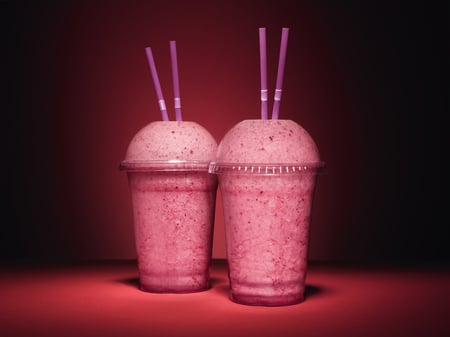Crowning the menu at Malibu-based chain SunLife Organics is the Billion Dollar Smoothie, a blend of 16 ultra-premium ingredients that some health enthusiasts promise will nourish the body and mind. It won’t enrich the wallet, though — the Billion Dollar Smoothie costs $28. (The Million Dollar Smoothie is a comparative bargain, at $15.95.)

The $28 price tag is due to exotic ingredients like goat colostrum, adaptogenic mushrooms and silica. (Oddly, the smoothie just tastes like vanilla.) While the health benefits of ingredients like these aren’t always proven, many customers are avidly seeking out ultra-premium smoothie ingredients.
Deciphering Premium Smoothie Ingredients
High-dollar smoothies seized the public imagination in 2016 when Gwyneth Paltrow published the recipe for the smoothie she drinks every morning — the “$200 smoothie,” as Buzzfeed dubbed it. It didn’t actually cost $200 (more like $10.50), but still, people obsessed. Can a smoothie really become a life-changing, health-enhancing potion? We can’t answer that question, but we can examine the premium ingredients that appear in smoothies like Paltrow’s and SunLife Organics’.
1. Adaptogens
Adaptogens are herbs and mushrooms that can help bolster the body’s natural response to stress. While the term “adaptogen” is recent in origin, the botanicals it describes do, in fact, have the ability to affect many types of hormonal functions, as University of Minnesota professor Dennis McKenna explains. Examples of adaptogens include maca (a root grown in Peru), ashwagandha (an ayurvedic herb), he shou wu (an herb used in traditional Chinese medicine that is said to promote longevity) and mushrooms like reishi, cordyceps, and lion’s mane. Moon Dust, Paltrow’s preferred blend of adaptogens, costs $20 per ounce.
Mainstream potential: Huge, particularly with mushrooms. “We’ve seen shoppers take a growing interest in medicinal mushrooms into more products—especially bottled drinks and supplements,” Elly Truesdell, Whole Foods Market’s global senior coordinator of local brands, product innovation, and development, tells Well+Good.
2. Green superfood blends
Putting leafy greens in smoothies is nothing new, but the newest trend is concentrated, dried green blends. SunLife Organics uses Vitamineral Green, a blend of plants (such as nettle, dandelion, basil and seaweeds), enzymes and probiotics. Amazing Grass Green Superfood, another popular blend, adds fiber, antioxidants, enzymes and probiotics to wheatgrass, spinach, broccoli and other greens. Vitamineral Green powder is about $3.68 per ounce; Amazing Grass Green Superfood is about $1.96 per ounce.
Mainstream potential: High. Superfoods like chlorella, spirulina and chlorophyll continue to be popular smoothie ingredients, and green superfood blends are claimed to pack even more nutrients in every dose. However, many health-food experts say that powdered greens are not equivalent to the real thing, like freshly-squeezed wheatgrass.
3. MCT Oil
The popularity of Bulletproof Coffee (coffee blended with coconut oil and grass-fed butter) brought attention to medium-chain triglycerides (MCTs). Found in coconut oil, these fat molecules allegedly boost brain function and promote weight loss. Some controversy surrounds the use of MCTs, however; coconut oil is also extremely high in saturated fat and can raise good and bad cholesterol levels alike. Bulletproof’s Brain Octane Oil, which is high in MCTs, costs about $1.44 per ounce.
Mainstream potential: High. There is high consumer demand for improved energy and focus, and “coconut everything” continues to be a hot food trend, as Whole Foods predicted.
4. Pearl Powder, Silica, Charcoal
These non-food smoothie ingredients are said to enhance beauty from the inside out. The blended Beauty Latte from The Moon Juice Cookbook calls for ¼ teaspoon of pearl powder — yes, real, ground pearls. Pearl powder has long been used in traditional Chinese medicine to treat skin and bone conditions. Silica, aka silicon dioxide, may promote skin healing and collagen formation, although “a clear biological function for silicon in humans has not been established,” according to WebMD. And activated charcoal has been a popular smoothie ingredient because it binds to toxins, removing them from the body. Charcoal’s medicinal properties are proven, but it can also bind to beneficial nutrients and even medication, meaning it should be consumed with care. The priciest of these smoothie ingredients is pearl powder, which is $16 per ounce from Moon Juice.
Mainstream potential: Limited. Unlike superfood ingredients that promise a broad array of benefits, these are more specialized. And while charcoal is trending at the moment (in things like black ice cream), its longevity is questionable.
5. Goat colostrum
Colostrum is the first milk produced by a mama goat (or any mammal, including humans), a watery but powerful blend of antibodies, fats, vitamins, minerals, carbs and proteins that’s intended to give a newborn a jump-start in life. Mt. Capra colustrum powder costs about $10.20 per ounce.
Mainstream potential: Less alluring than pearl powder, goat colostrum may be a tough sell.
So which, if any, of these premium smoothie ingredients will your customers embrace? Green powders or adaptogenic mushrooms could be a hit, or you may decide to stick to basics. After all, as The Guardian writes, “the obsession with expensive, exotic superfoods also means we forget the easy, cheap foods that are more likely to keep us healthy – apples, oranges, broccoli and milk.” We’ll drink to that.
If you have a fun or interesting story idea, please submit it here. The best stories will be developed and published on our blog to be distributed to the international HBC Community, with your name attached. A little publicity can always help to grow your business and awareness.


